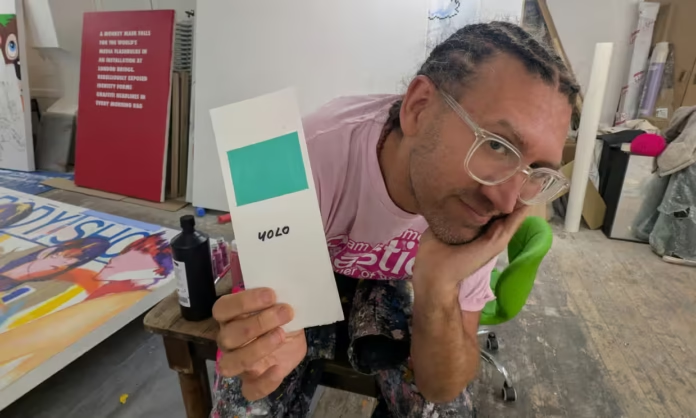British artist Stuart Semple, renowned for his crusade to democratize access to unique colours, has claimed to recreate in paint a new hue recently reported by scientists at the University of California, Berkeley. The original colour, dubbed “olo” by the researchers, emerged during a pioneering experiment that used laser pulses to stimulate human retinas beyond their natural capacity.
While the Berkeley scientists emphasize that the new colour cannot truly be replicated, Semple is nevertheless offering his version—cheekily named “yolo”—for £10,000 per 150ml jar, or at a much lower price of £29.99 for self-declared artists.
The Science Behind ‘Olo’
In a study published in Science Advances, researchers from UC Berkeley sought to expand the boundaries of human colour perception. Using a laser, they stimulated individual M-cones—one of the three types of colour-sensitive photoreceptors in the retina—almost exclusively. Typically, natural light activates a combination of L (long-wavelength/red-sensitive), M (medium-wavelength/green-sensitive), and S (short-wavelength/blue-sensitive) cones.
READ MORE: MIT Develops ‘Relevance’ Robot System to Assist Humans by Identifying Key Objects in Real-Time
Since M cones usually work in tandem with the other two, no naturally occurring light solely excites them. This experiment thus induced an entirely novel visual sensation, described as a blue-green hue beyond the conventional human experience. Appropriately, the scientists named the colour “olo,” referencing the binary code “010,” with the ‘1’ corresponding to the M cones.
Austin Roorda, a vision scientist involved in the project, noted, “It’s impossible to recreate a colour that matches olo. Any colour that you can reproduce would just pale by comparison.”
Semple’s Quest to Democratize Colour
Known for his rebellious stance against colour exclusivity, Semple’s creation of “yolo” is the latest in a series of provocations aimed at breaking monopolies over artistic materials. Previously, he famously developed “Black 3.0,” marketed as the world’s blackest paint available to everyone—except artist Anish Kapoor, who had exclusive rights to another ultra-black pigment. Semple also produced his own version of Yves Klein’s ultramarine blue, defying proprietary claims over iconic colours.
In his attempt to match the elusive olo, Semple used a more conventional approach: blending pigments with fluorescent optical brighteners. These substances absorb ultraviolet light and re-emit it as visible blue light, enhancing perceived brightness. A spectrometer was employed to analyze and fine-tune the paint, seeking the closest match to the described sensation of olo.
“I’ve always thought that colour should be available to everybody,” said Semple. “I’ve fought for years to liberate these colours that are either corporately owned or staked by scientists.”
An Artistic Interpretation, Not a Scientific Replica
Despite his efforts, Semple readily acknowledges the limitations. “I think they’ve triggered an experience in people that they’re approximating to a colour. What I’ve done is tried to make an actual colour of that experience,” he explained.
Roorda, while intrigued by Semple’s venture, remains skeptical about the fidelity of any physical reproduction of olo. He remarked humorously that he might buy a jar—though not for £10,000—and even joked about trying to simulate the experience by mixing the melon-flavoured Midori liqueur with Blue Curaçao, describing the resulting drink as “a bit foul” but increasingly evocative of olo after a few sips.
Accessibility Versus Exclusivity
Semple’s initiative once again raises profound questions about the ownership of sensory experiences and materials. Should novel discoveries in colour, light, or sound be guarded for the privileged few, or shared freely among creatives and the public?
The artist’s decision to price “yolo” at a steep £10,000 for collectors and £29.99 for working artists underscores his philosophy that art supplies should not be the domain of the elite. This pricing strategy, while provocative, is consistent with Semple’s previous campaigns promoting artistic inclusivity.
The Broader Implications for Art and Science
The controversy surrounding “yolo” is more than a quirky sideshow—it highlights the fragile boundaries between scientific discovery, commercial exploitation, and artistic interpretation. While scientists push the limits of human perception through experimental methods, artists like Semple seek to translate these ephemeral phenomena into tangible experiences accessible to all.
This tension also reflects a broader cultural shift where traditional divisions between art, science, and commerce are increasingly blurred. As Semple’s work illustrates, artistic practice today is not just about aesthetics but also about activism, ethics, and accessibility.
Looking Forward
As Dianarama prepares to reveal hidden truths about historic media scandals, and other artists and scientists continue probing the frontiers of perception, Stuart Semple’s “yolo” stands as a playful yet pointed reminder that innovation often invites dispute—and that sometimes, the act of trying to capture the uncapturable is itself an artistic statement.
Whether “yolo” truly matches the unattainable olo, or merely gestures toward it, it has already succeeded in sparking global conversations about the meaning of creativity, ownership, and the joy of colour beyond the visible spectrum.
